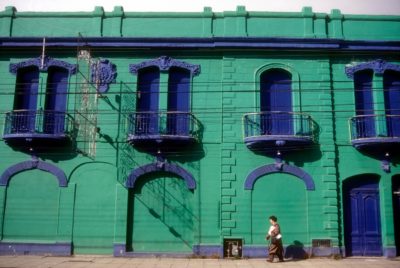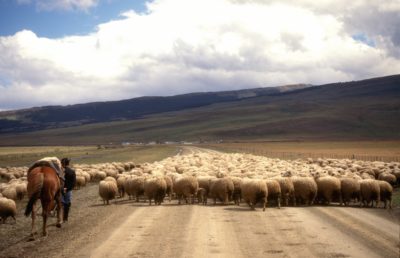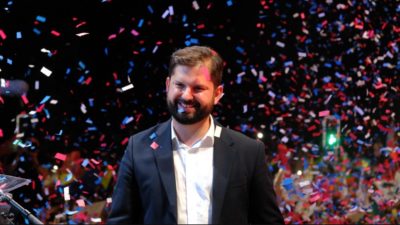by Bill Murray

Charles Darwin was just shy of 24 years old, his eyes open in wonder as the HMS Beagle slid along the shore of the largest island in the archipelago of Tierra del Fuego. His eyes grew wider as bonfires flared along the water’s edge. “They must have lighted the fires immediately upon observing the vessel, but whether for the purpose of communicating the news or attracting our attention, we do not know,” he wrote.
These shore people called themselves Ona and Yaghan. Canoeists and fishermen adept at navigating the labyrinth of channels in these straits, in wintertime they kept fires constantly stoked for warmth. The Yaghan wore only the scantest clothing despite the cold. To fend off wind and the rain, they smeared seal fat over their bodies.
The Ona lived across the strait, on an island just visible through the spray and mist. History calls them fierce warriors who adorned themselves with necklaces of bone, shell and tendon, and who, wearing heavy furs and leather shoes, intimidated the bare-skinned Yaghan. Darwin gave them their backhanded due, calling them “wretched lords of this wretched land.” An acerbic settler once described life hereabouts as 65 unpleasant days per year complimented by 300 days of rain and storms.
The main town at Chile’s southern tip is Punta Arenas, with 145,000 people a proper town with a proper town park, which is home to a statue of Magellan and its smooth, often-rubbed toe. If you rub the toe they say you’ll be sure to come back. Twenty two hundred kilometers south of Santiago, you take what entertainment you get. So we rubbed the toe.
A band of cold rain swept over the Hotel Cabo de Hornos, churning the Strait of Magellan dirty gray. Punta Arenas’s “oldest and grandest” hotel was, well, it was just a hotel, all of its walls painted a determined shade of mustard. We and the staff watched sleety squalls spray over the strait.
By the time you reach the town of Puerto Montt in Chile’s Lakes District, the Pan American highway has long since made its point, 816 miles of Chile to the north and no fancy roads heading south. The farther you go, the more determined you’ll need to be to get all the way down to Punta Arenas, and you’ll have to be plenty determined, for there are still over 800 miles to go.
I walked to the water, stepping lightly around potentially threatening mongrels holding a Purina warehouse at siege, and I put my hand in the chilly Strait of Magellan – right there amid floating plastic bags and candy wrappers.
One passenger ship was calling just now. Across the strait, looking just about west to east, low hills rose around a town called Porvenir. It wasn’t very far but I couldn’t make out much. We’d come down to the southern tip of Chile to have a look around, to see what makes it unique.
Punta Arenas is a place where your rental Nissan Saloon sedan comes equipped with a wire screen to prevent gravel cracking its windshield, because blacktop roads end where towns do. We looked ridiculous, we thought, motoring off toward the hills. A quarter inch mesh of expanded metal surrounded the glass all around, far enough away for the wipers to operate underneath.
A foot-square hole was cut in front of both the driver and the passenger with more mesh hinged over it so that the normal position was open for ‘city’ driving, but for your serious gravel roads you could pull a string that reached inside your side window and roll the window up really fast to catch the string and bring the protective panel down. That sealed the windshield against rocks and provided you with a good, oh, thirty percent view of the world in front of you.
The bottom of the continent is a place where beyond the city blacktop there are virtually no houses and there is virtually no traffic. Except for there being roads between towns, things looked a little like summer in coastal Greenland. There were tiny white wildflowers and there were no trees.
Northbound at a place called Reubens, where stood a settlement of a few buildings, trees began to appear. The Nire, or Notofagus antarctica, a native species, grows to ten crooked and branched meters, compacted and dominated by the winds. Fields of tree trunks stood twisted and contorted by the wind. The forest presented in two shades of green – the needles and lighter clinging lichen. Rolling hills replaced the horizon-to-horizon flat. You could watch sheets of rain approach from miles away and wash overhead on their march to the other horizon. Snow topped a few low peaks.
 A thousand sheep blocked the road. Gauchos and a squad of dogs marched them forward. The dogs ran and darted, responding to the mens’ whistles, and moved the sheep off the road for us. You wouldn’t need to play with these dogs at night. They’d be worn out.
A thousand sheep blocked the road. Gauchos and a squad of dogs marched them forward. The dogs ran and darted, responding to the mens’ whistles, and moved the sheep off the road for us. You wouldn’t need to play with these dogs at night. They’d be worn out.
Guanacos lived everywhere, grazing on cliffs like mountain goats. Maybe four feet tall at the shoulders, llama-like, brown and white, from the camel family, they may weigh 200 pounds. They live in family groups, and do this funky juke with their long necks when they run.
One other thing about far southern Chile – Punta Arenas is the home of Chile’s new president, Gabriel Boric, a descendant of South Slavs. Maybe 20,000 of Punta Arenas’s 145,000 people are of Croatian descent, and there are around 200,000 Croatians in Chile. Boric’s family, among many others, emigrated in 1897 from Ugljan, an island of vineyards and olive groves opposite the coastal city of Zadar.
By the end of the nineteenth century descendants of the Ona and Yaghan still lived in the fjords and all across the rocky outcrops of Tierra del Fuego, but once Chile and Argentina agreed on their border in 1881, the call went out for settlers. As it happened, just then the catastrophic accidental import of an insect pest to the Rhône Valley was destroying vineyards from France all the way to Dalmatia. Boric’s ancestors fled the plague, abandoning Croatia en masse for a new home in the wild, wild south.
•••••

In March, the bearded young Boric joined the historic line of left wing Latin American leaders when he assumed Chile’s presidency at age 36 years and one month; at the time he was the world’s youngest leader. His administration came to office with a rare gift: the chance to draft a new constitution.
Three years before and innocently enough, then-president Sebastián Piñera allowed a fare hike on Santiago’s metro system. A 30 peso hike, about four cents, wouldn’t be a casus belli most places, but in Santiago, protests led to 29 deaths, looting, the torching of metro stations and a state of emergency. The uprising, led by students, wasn’t about the pesos. It was about decades of neoliberalism and remnants of the Pinochet dictatorship they couldn’t shake loose.
Piñera rescinded the fare increases but birthed a new hashtag, #ChileDesperto. As the protesters said, Chile woke up. The movement gained a name, the “Estallido Social,” social explosion, leading to the drafting of the new constitution and a referendum on its adoption.
The proposed constitution was anything but conventional. It called for a national single payer health system, free education including college, the right to abortion with few restrictions in a two-thirds Catholic country and the guarantee of Indigenous rights on a continent where, as Carlos Barón has written, “the equivalency of the ‘N’ words is still the word ‘Indio.’”
To understand just how radical the proposed constitution was, a brief step back:
Salvador Allende, a lifelong Chilean politician, ran for president in 1958, 1964 and finally won in 1970. First a member of the Chamber of Deputies in 1937 and subsequently a Senator, cabinet member and party secretary, he was about as known a quantity as you’ll find.
Nevertheless, in a place as far from the daily heartbeat of the Cold War as you could be, Allende’s socialist vibes unnerved the Nixon administration. Secretary of State Henry Kissinger once briefed newspapermen that Chile could be a “contagious example” that would “infect” U.S. allies in Europe. Ponder that. Chile might infect European allies.
On September 11th, 1973 at high noon, British made Hawker jets bombed the presidential palace in Santiago. Allende’s rallying cries on radio failed to summon support, military police abandoned the presidential palace and Allende was killed. General Augusto Pinochet, head of the armed forces, assumed control.
A young lawyer and right-wing ideologue named Jaime Guzmán, wrote a new constitution for the new regime. Guzmán supported free markets and authoritarianism, idolizing Frederik Hayek and Fransisco Franco. During Allende’s administration he had joined a fascist terror group.
His constitution left the government in a “subsidiary state,” subordinate to private business, reducing it to subsidizing the private sector’s efforts in basic areas like education, health and pensions. The government was unable to intervene in the economy unless explicitly allowed.
Notably, the Pinochet constitution granted the “rights of private citizens over waters,” codifying corporate confiscation of rivers for, for example, the mining industry, and rendering the government helpless to stop it. Aside from small bore reforms in 2005 under the presidency of Ricardo Lagos, this constitution, with its state subsidiarity, still stands.
By the election of Gabriel Boric the Pinochet constitution was 42 years old and showing its age. It was written to secure Pinochet’s military regime and hold the market, not the government, responsible for social services. Where the government was responsible was to ensure that mining, and natural resources, not be regulated.
Back to the present.
Since the Pinochet constitution was largely the product of one man, Guzmán, Chile determined that a new constitution would come from delegates chosen in open, democratic national elections held in 2021 that chose 155 delegates to a constitutional convention – with seventeen seats reserved for indigenous groups and gender equality. The result? The largest bloc was made up of independents, many with limited political experience. Only some 13% had held political office before; it showed.
About twenty percent of the delegates came from the right. This may or may not have been a fair snapshot of the electorate, but those numbers allowed left and center-left delegates a comfortable enough majority to ally and return an overfull document containing 388 articles, including vague and exotic declarations like “nature has rights” and animals are “subjects of special protection.”
Chile would be declared an “ecological nation” and a “plurinational country,” with at least eleven Indigenous groups given autonomy as “nations” within the country. The draft also contained the reasonable enough notion that there should be some limits on corporate confiscation of water for mining.
For all its good intentions, the convention had produced a vague and aspirational document giving entrenched interests a surfeit of targets. The draft included, for example, restitution for historically Indigenous lands.
There was another problem: a steady stream of questionable behavior by convention delegates themselves. Some tried to shout down the national anthem on opening day. One was forced to resign after falsely claiming to have cancer. Another tried to cast a vote while taking a shower.
Still and with all that, I’m mystified by all this What’s the Matter with Kansas stuff, in which working-class and poorer people vote counter to their interests. A popularly elected body offered up free education, gender parity (married couples couldn’t get divorced in Chile until 2004) and the right to decent housing. Yet this was rejected in every one of Chile’s 16 regions and 338 of 346 municipalities. What happened?
Part of the answer is the predictable, aggressive TV ad campaign run by vested interests. Anyone who has seen a television in the United States this election season will sympathize. To turn on the television on was to be implored to reject this scary, demonic document.
Opponents took to morning talk shows and the evening news to repeatedly denounce the document as “extremist” and “poorly written,” while conservative think tanks produced opinion polls of doubtful accuracy showing that most people would vote down the new draft. Social media spread disinformation, and fake copies of the draft constitution circulated, with doctored articles. A senator named Felipe Kast charged on conservative radio that the draft constitution “allowed for abortion until the ninth month of pregnancy.”
No surprise that exit polls suggested people were confused. Rechazo (Reject) partisans, it’s said, spread rumors that the new constitution would abolish home ownership and allow Indigenous communities to summarily secede. A Rechazo spokesperson, a university law student a year younger than Gabriel Boric named Fransisco Orrego, claimed the document would abolish people’s rights to own their homes if they had bought using social subsidies, a common circumstance.
For the first time ever, non-felon prisoners were allowed to vote. Here is a measure of the effectiveness of Rechazo’s campaign to muddy the waters: of fourteen prisons, only one voted to approve the draft constitution. The Tocopilla prison in Conceptión, the only one to approve the draft, was also the only prison where “physical copies of the draft constitution were actually distributed.” The other prisoners had only media to inform their vote, and they all voted no.
The defeat and consequent retention of the current constitution is an unattractive option, as meanwhile private sector actors will continue to use “state subsidiarity” to block reform. Further, the whole process led Chileans to a low opinion of the country’s new leader.
It’s a real shame to waste all that promise. After a fast start, that the draft constitution was roundly rejected has dealt a tough and possibly fatal blow to the young reformer just six months into the job. Gabriel Boric hit his all-time low approval rating in October, at 27 percent. He may already be consigned by a skeptical public to sitting out a few elections and attempting to return one day not as a firebrand from the left, but as a more properly aged traditional pol.
